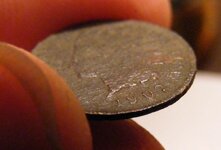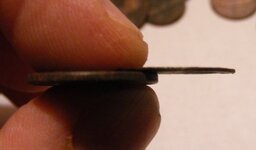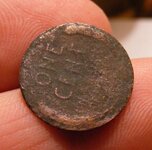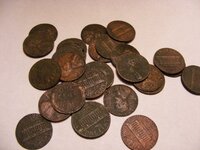Navigation
Install the app
How to install the app on iOS
Follow along with the video below to see how to install our site as a web app on your home screen.
Note: This feature may not be available in some browsers.
More options
You are using an out of date browser. It may not display this or other websites correctly.
You should upgrade or use an alternative browser.
You should upgrade or use an alternative browser.
Funny find in my pocket
- Thread starter WHADIFIND
- Start date
gman7665
Sr. Member
- Mar 1, 2013
- 378
- 172
- Detector(s) used
- Garrett Ace 350
- Primary Interest:
- All Treasure Hunting
Mine was a Box find and Not a Dig find , Pretty Tricky if it is the acid test  Just Boggles Me with all the detail left on the coins? LOL
Just Boggles Me with all the detail left on the coins? LOL
 Just Boggles Me with all the detail left on the coins? LOL
Just Boggles Me with all the detail left on the coins? LOLhuntsman53
Gold Member
Thanks for the confirmation. It's what I suspected as well. Was this a common school project or something?
I am sure that some were experiments in school, while others were due to some folks having too much time on their' hands and some were probably made to dupe unsuspecting Collectors.
Frank
Last edited:
mirage83
Hero Member
I seem to recall there being some sort of science class thingy where a coin is reduced like this but I'm not sure. Thought I'd post it and see if it rings any bells. Thanks for peeking! COME ON SPRING!!!!
Here's a link to the science class thingy (or at least A science class thingy) on shrinking coins and other neat stuff done with electricity. It might or might not explain your penny, but it's interesting regardless.
Bert Hickman's TeslaMania Web Site - Tesla Coils, Lichtenberg Figures, and Quarter Shrinkers!
WHADIFIND
Gold Member
- Thread starter
- #24
Here's a link to the science class thingy (or at least A science class thingy) on shrinking coins and other neat stuff done with electricity. It might or might not explain your penny, but it's interesting regardless.
Bert Hickman's TeslaMania Web Site - Tesla Coils, Lichtenberg Figures, and Quarter Shrinkers!
Yep, I'm a big fan of sciency thingys.

Makes more sense then counterfeiting pennies. LOL
Thanks!
gunsil
Silver Member
- Dec 27, 2012
- 3,863
- 6,205
- Detector(s) used
- safari, ATPro, infinium, old Garrett BFO, Excal, Nox 800
- Primary Interest:
- All Treasure Hunting
Putting pennies on RR tracks makes them as big as quarters, thinner than dimes, and there is little definition left, I almost can't believe the older guys here haven't done it numerous times. Every kid I went to school with and most of my many cousins have done it. Doesn't work well with Zincolns though, gotta use the copper ones. Acid removes the surface metal evenly through out and around the edges, hence the rough but complete images. I guess I was just one of those kids who liked to put coins on the RR tracks, blow things up with cherry bombs and ashcans, coat things with mercury, and dissolve things in acid. DO NOT try to dissolve Zincolns in acid, you will get a violent reaction!! The copper pennies dissolve more slowly, depending on the strength of the acid. I make jewelry and use nitric acid for etching sterling silver with designs and also use it to remove "fire scale" the copper in the sterling that comes to the surface with the high heat of silver soldering. Naturally for someone of my devious bent I have subjected many coins and other objects to acid baths just to see what happens. The difference in the two acid dipped pennies surfaces on those posted is due to the strength or purity of the acid used. A weaker solution dissolves the coin more slowly with less pitting while a stronger solution does it more rapidly with deeper pitting.
Last edited:
huntsman53
Gold Member
The main reason that details are still visible or strong on most acid bath coins is due to the metal where the details, lettering, Date are on the coin is more dense from the compression from striking (minting). The acid eats away the less dense metal around these and in the fields thus the details, lettering and Date which are more dense, are still visible. This is similar to restoring Dates on well worn Buffalo Nickels or restoring Serial Numbers that have been filed or ground off of guns.
Frank
Frank
curbdiggercarl57
Silver Member
- Nov 19, 2007
- 4,362
- 1,043
- 🏆 Honorable Mentions:
- 1
- Detector(s) used
- Whites Silver Eagle, DFX, Shadow X-2
- Primary Interest:
- All Treasure Hunting
I found a pile of Wheats, older memorials, and a few silver dimes that were toasted like that near a electrical plant out here in Denver, and posted photos a while back.
People said that they were probably either put in electrical light bulb sockets, or something larger, and it made sense.
If I can find where I put them, I'll run off a scan.
My two cents anyway.
Carl
People said that they were probably either put in electrical light bulb sockets, or something larger, and it made sense.
If I can find where I put them, I'll run off a scan.
My two cents anyway.
Carl
curbdiggercarl57
Silver Member
- Nov 19, 2007
- 4,362
- 1,043
- 🏆 Honorable Mentions:
- 1
- Detector(s) used
- Whites Silver Eagle, DFX, Shadow X-2
- Primary Interest:
- All Treasure Hunting
Hey, not trying to sidetrack, real glad you posted your find. Here's some quick shots. Couldn't find the silver dimes, even wafer thin I probably sold for scrap. Glad you got me to find these, I didn't remember the Indian!
Attachments
WHADIFIND
Gold Member
- Thread starter
- #29
Hey, not trying to sidetrack, real glad you posted your find. Here's some quick shots. Couldn't find the silver dimes, even wafer thin I probably sold for scrap. Glad you got me to find these, I didn't remember the Indian!
Heck no! No harm, no foul. I knew I'd seen this type of coin before. Just never stopped to think how they might be coming to be nor why.

Lots of ways for it to happen. I still wonder though if there is a recognized mint error that might cause this.
Thanks!
jewelerguy
Gold Member
I remember my brother bringing home a penny that looked identical after his high school science teacher showed them an experiment back in the 70's
bountyhuntergirl86
Bronze Member
- Nov 29, 2012
- 1,176
- 725
- Detector(s) used
- Bounty Hunter Quick Draw II & Fisher F2
- Primary Interest:
- All Treasure Hunting
I think it had to do with some type of acid bath they didn't science class. Found a 45 wheat in my change that was like..
gman7665
Sr. Member
- Mar 1, 2013
- 378
- 172
- Detector(s) used
- Garrett Ace 350
- Primary Interest:
- All Treasure Hunting
The Electricity would explain the black spot on My 65 cent I guess... Thanks for the Awesome Info ...H.H.
curbdiggercarl57
Silver Member
- Nov 19, 2007
- 4,362
- 1,043
- 🏆 Honorable Mentions:
- 1
- Detector(s) used
- Whites Silver Eagle, DFX, Shadow X-2
- Primary Interest:
- All Treasure Hunting
Now that I'm more clear headed, I'm recalling that people would also put them in the old fashioned fuse boxes. the constant current running through the coin would slowly shrink the size.
Users who are viewing this thread
Total: 2 (members: 0, guests: 2)














